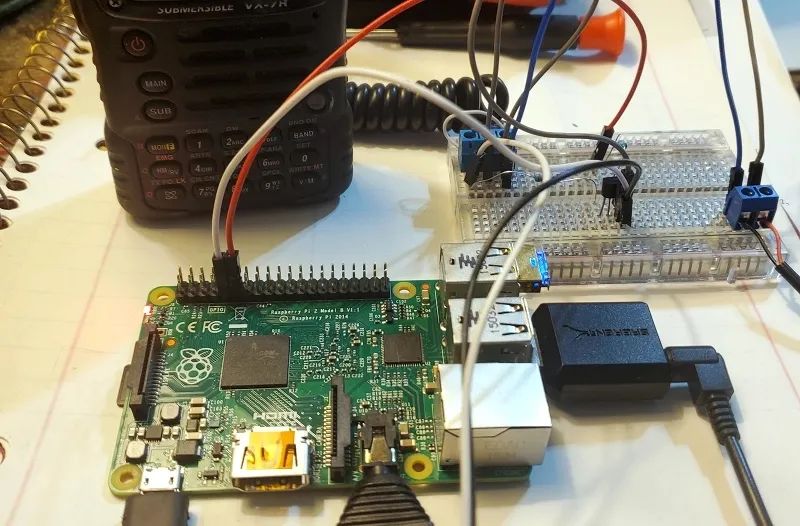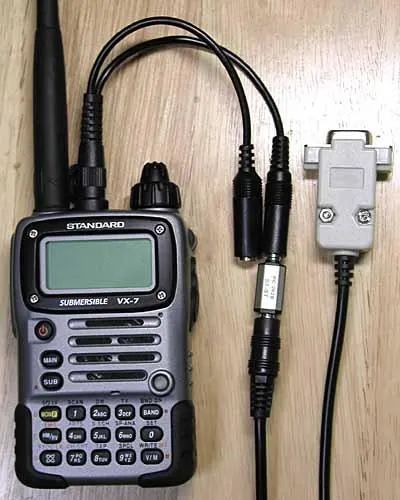

Al Williams (Call sign: WD5GNR) wrote about Hambone on Hackaday, which acts as a computer interface for the walkie-talkie by listening to DTMF commands and can activate the walkie-talkie’s PTT button to play audio via the Raspberry Pi’s GPIO.
Controlling a Walkie-Talkie with Raspberry Pi
By: Al Williams
Today’s amateur radio equipment often has remote control capabilities, but they usually communicate with computers rather than operators. On the other hand, Hambone functions similarly to an amateur radio robot, decoding TouchTone digits and taking actions based on received commands, such as pressing buttons on the walkie-talkie and reading the weather.
The code uses Python and employs numpy’s fast Fourier transform to identify digits. Compared to the Goertzel algorithm designed for 8-tone signals, we are interested in testing its performance: there are 4 rows of tones and 4 columns of tones. On the other hand, FFT is very convenient and is clearly fast enough for this application.

Source: https://baike.baidu.com/item/VX-7R/10776703
This project is actually derived from a failed project by notpike, aimed at sending paging tones.It is set up for specific Yaesu handheld devices, but any walkie-talkie can be used.However, some tricks are involved if you connect it to the same walkie-talkie.
Remote operation is becoming increasingly common, and if you’re looking to build your own remote setup, this could be a good start. It can be done for around $50.
The software was developed by Jacob WU7ANG (NotPike):
https://twitter.com/ifnotpike/status/1270225880128749568
https://bad-radio.solutions/notes_yaesu_rpi
Hambone:
https://github.com/notpike/Hambone
User Comments:
VE3NNM:
Using DTMF for hardware remote control in radio is very useful; I did this with my VIC20 and Commodore 64 in the 80s. The TTL level outputs from DTMF decoder chips like ‘202’ and ‘8870’ from many manufacturers were directly compatible with the joystick ports on Commodores, allowing me to check memory locations on the computer via PEEK to determine which DTMF tone was detected.
The DV (Digital Valid) pin of the DTMF decoder chip activated the FIRE pin on the game board port, which was a piece of cake. I built a radio/telephone interface called “Simple Auto Patch” and established several remote control projects to turn on/off lights in the yard, etc.
Given the low cost of DTMF decoder chips, I am puzzled why someone would write an entire DTMF decoding routine in software instead of doing it this way as an intellectual challenge. It seems an unnecessary complexity that is prone to errors for completing simple tasks, reminiscent of those who use Arduino to accomplish what a 555 timer chip can do. I would rather spend a little money to let professionals decode DTMF using built-in on-chip filters and anti-aliasing features and save the code needed to accomplish the tasks I want to achieve with that device.
Joseph Eoff:
A radio technician I know told a similar story.
Somewhere there was a paging transmitter setup, and the person I know was sent to do some maintenance work; I don’t remember what the job was.
He arrived on-site and found the walkie-talkie on the shelf.
The plastic casing of the walkie-talkie had melted and flowed down over the entire transmitter.
The relay that triggered the transmitter when sending paging signals had stuck. The transmitter had been running continuously for several days (or weeks). The weather got hot, the casing melted, but it continued to transmit.
Motorola made some nice walkie-talkies at the time. This incident happened in the late 1980s, and I heard about it in the early 1990s.

[New Product Information Station] Sold for 537 Yuan, 8GB Raspberry Pi 4 Now on Sale, Making SDR Stations More Efficient
[New Product Recommendation] Raspberry Pi 4: Faster CPU, Dual Displays, Gigabit Ethernet, and Up to 4GB RAM, Can Be Used as an SDR Station
[Ham DIY] A Tri-Band Transceiver for Satellite Tracking, RTL-SDR Dongle, and Raspberry Pi Packed in One Box
[Ham DIY] TV Antenna Tuner + Dongle/Raspberry Pi = $40 SDR Wideband Receiver
[Ham DIY] Unboxing Video Explanation | Digital Mode Amateur Radio Kit for Raspberry Pi, Simple and Pure
